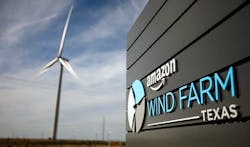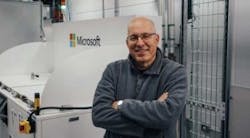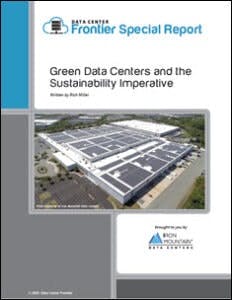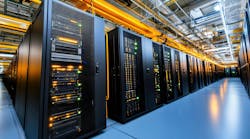As the world confronts the growing urgency of the climate crisis, top cloud computing companies are stepping up their sustainability efforts. Although data center builders are already the largest adopters of green energy, the recent storms and heat waves are prompting a renewed sense of purpose on climate.
At Data Center Frontier we’ve spent years tracking the data center industry’s initiatives on sustainability and climate defense. Recently we’ve seen a growing recognition that the cloud computing sector must step up its efforts on climate change to safeguard the future of the planet.
“We should have a much bigger purpose, and really think about what legacy we leave behind,” said Christian Belady, a Microsoft distinguished engineer and vice president of its datacenter advanced development group. “Is it going to be just these massive data center, buildings? Or do we really rethink the future, and still meet all of the needs of our customers AND the planet.
“Clouds don’t exist without a planet, or without oceans,” said Belady. “It’s in all of our interests to work collectively.”
That commitment can be seen in a range of recent industry responses, including:
- A flurry of new projects to advance web-scale usage of energy storage, hydrogen fuel cells, biofuels and other alternatives to diesel.
- Enabling royalty-free access to patents for low-carbon technology from leading cloud innovators.
- Deeper sustainability and ESG (environmental, social and governance) commitments that go beyond offsets and carbon neutrality, advancing science-based targets and net-zero goals.
- Broader adoption of recycling and zero-waste strategies to support a “circular economy” for servers and other IT assets.
A Collective Vision: Every Click Improves the Future
The growing urgency of the climate challenge was clear in a new UN scientific assessment released this month, which found that fossil-fuel emissions remain too high to prevent intensified global warming. However, a short window remains in which countries and corporations can act to head off worst-case outcomes.
The changing climate can be seen in weather disasters across the globe, including wildfires fueled by heat waves in the Western US and Europe (even Siberia), and destructive floods in Germany and China.
“Events over the past year-and-a-half have demonstrated that now more than ever, ESG belongs at the forefront of our business,” said Bill Stein, the CEO of Digital Realty.
One of the groups embracing this discussion is Infrastructure Masons, a group of data center executives – the “builders of the digital age” – who brainstorm strategies to make the industry more diverse and sustainable. Founder Dean Nelson says the group has been focused on how cloud builders can raise their game, enlisting decision makers from the largest Internet companies.
“Over the last 15 months, iMasons has unified the industry on a common sustainability vision – every click improves the future,” said Nelson. “It’s a future where digital infrastructure contributes to the global economy and society without harming the planet. This is such an important balance to achieve.
“But for it to succeed, we have to come together as an industry to ensure that our work is greater than the sum of its parts,” Nelson added. “But the big question remains – is this enough for us to save the planet?”
A History of Leadership. But More is Needed
The data center industry has been a force for positive change on climate action over the past decade, with cloud computing platforms pioneering advances in sustainable operations and corporate adoption of renewable energy. As the largest cloud builders deepen their commitments to green energy, the entire data center supply chain is being incentivized to embrace sustainability in new ways.
Microsoft recently outlined a vision to run its Azure “planetary computer” and its 4 million servers using entirely zero-carbon sources, including hourly matching of renewable energy. Microsoft says it will work with utilities to “lay the groundwork for a decarbonized grid.” Microsoft has also been vocal in calling for the industry to move beyond diesel as a fuel source for generators, testing hydrogen-based fuel cells and adopting biofuels in generators, and also pursuing “moonshot” research to store data in DNA and holograms, approaches that could use far less power than current IT storage.
Christian Belady, distinguished engineer and vice president of Microsoft’s datacenter advanced development group, stands next to a two-phase immersion cooling tank at a Microsoft data center. (Photo: Microsoft)
Belady said these technology developments “can rethink what a data center is. That’s what we’re working on now.”
Microsoft isn’t alone, as other large cloud computing platforms have outlined similar long-term sustainability goals, along with large purchases of renewable energy and innovations to slash the carbon impact of data centers.
Google has purchased more than 6 gigawatts of renewable energy to support its data centers, and is pioneering the use of large lithium-ion batteries and geothermal energy. Google has also used artificial intelligence to improve its cooling efficiency, and create a “climate-aware” infrastructure that can move workloads between data centers to optimize their use of clean energy.
“Preventing the worst impacts of climate change will require decarbonizing the world’s electric grids, as fast as possible,” said Maud Texier, Carbon Free Energy Lead for Google. “Google is committed to doing as much as possible to clear a path for others and drive collective action to achieve this goal.”
Switch has been another pioneer, developing utility-scale solar generation and energy storage to support its operations. Amazon, Facebook and Apple have procured substantial amounts of renewable energy to support their data centers. Multi-tenant data center developers like Digital Realty, Aligned and Iron Mountain have also lined up green energy for their data center clients.
Strategies for Larger Impact
For al the progress, there’s no time for the cloud industry to take bows or rest on its laurels. As it becomes clear that current global actions on climate are falling short of targets, data center companies are looking to move beyond symbolic efforts or targets tied to a single strategy.
Setting a Higher Bar on ESG, from ‘Soil to Software’
The two largest players in the multi-tenant market, Digital Realty and Equinix, have embraced the Science-Based Targets Initiative, which seeks to align corporate ESG commitments in line with the latest climate science on meeting the goals of the Paris Agreement – to limit global warming to well-below 2°C above pre-industrial levels and pursue efforts to limit warming to 1.5°C.
Others are aiming for a goal of “net zero” emissions, a commitment that goes beyond carbon neutrality to address other greenhouse gases (such as methane, an important focus in the new UN report).
Solar panels and windmills line the roads and parking areas at the Vantage Data Centers campus in Ashburn, Virginia. (Photo: Vantage Data Centers)
“As major consumers of power and land, data center operators have an undeniable responsibility to aggressively reduce emissions and lessen environmental impacts wherever possible.” said Justin Thomas, chief technology officer at Vantage Data Centers. “This is why we’ve set our target at net zero rather than carbon neutral. Our goal is to be a sustainability leader, and we are setting interim reduction goals that touch every part of our business.”
There’s also a growing case to go beyond scope 1 (direct on-site or vehicle emissions) and scope 2 (indirect emissions from purchased energy like heat and electricity) and address scope 3 emissions that include the indirect emissions from the supply chain and partners.
“We need to broaden our scope to tackle the harder questions and challenges from scope 1 to scope 2 and 3 but also across the supply chain and tech stack – from the “Soil to the Software” as I call it,” wrote Zahl Limbuwala, a veteran executive in data center management, in a LinkedIn post. “It’s now high time to step up as an industry to the next level of challenge and our responsibility as a group of like minded people that can get stuff done.”
Patent Access to Drive Innovation
In an unusual climate collaboration, Facebook, Microsoft and Hewlett Packard Enterprise are providing royalty-free access to hundreds of patents for technologies that can reduce carbon output. The 453 listed patents in the Low Carbon Patent Pledge cover power management, enabling zero-carbon energy sources, thermal management and data center architecture and design, including patents for Microsoft’s underwater data center.
DCF Special Report: Green Data Centers and The Sustainability Imperative.
“The world needs radical collaboration to meet this critical moment in the climate crisis,” said John Frey, Chief Technologist for Sustainable Transformation at Hewlett Packard Enterprise. “To achieve net-zero emissions by 2050, we need to work together to innovate faster. By opening up these patents, we hope to help accelerate and encourage innovation by enabling others to build upon our work.”
“This is precisely the kind of initiative that’s needed to combat the potentially catastrophic effects of climate change,” said Jorge Contreras, Professor of Law at the University of Utah and an expert on intellectual property law. “History has shown that voluntary pledges of patents can help to promote new technologies and encourage their adoption around the world.”
Water Scarcity and Stewardship
As the data center industry has confronted its environmental responsibilities, water has often been a secondary concern compared to electricity, a function of power’s more direct impact on carbon footprint. That has begun to change in recent years, as changing weather patterns have raised awareness of how climate change may impact water availability. The profound drought in the Southeastern U.S and extreme heat in the Pacific Northwest have put an exclamation point on the issue.
The cooling water supply system in a Google data center in Atlanta, which is one of the company’s sites using recycled water to reduce its impact on the local water supply. (Image: Google)
This also means more media and government scrutiny about data center water use. Data center builders have used a variety of techniques to reduce their water use and community impact, including use of fresh air cooling and other low-impact cooling, and the use of recycled “grey” water systems,
Data center operator’s sensitivity to water conservation was clearly seen in Microsoft’s recent announcement of its new cloud region in Phoenix, which featured a multi-faceted approach water concerns that included technology, community outreach and collaboration with conservation groups. This template will become familiar for hyperscale projects in areas facing water scarcity. Facebook has made a similar commitment for its new project in Mesa.
A Greener Supply Chain and the “Circular Economy”
Extending ESG priorities into supply chains creates room for new approaches to reuse and recycling. Facebook uses fiber-filled polypropylene (NFFPP) — a nature-based derivative from renewable jute fibers — as a replacement for petroleum-based plastic server components that had high carbon impact.
Facebook has also replaced its traditional lead-acid batteries with lithium-ion units for its rack-level battery backup units (BBUs). Since the lithium-ion units are more durable, their lifespan exceeds the typical hardware refresh cycle, allowing Facebook to reuse 95 percent of its lithium-ion BBUs , It now uses close to 600,000 of these units across its data center fleet
Another example of this “circular economy” of recycle and reuse is ITRenew, which decommissions hyperscale data centers and recycles IT hardware for reuse by enterprises and network operators, extending the lifespan of these cutting-edge assets.
“You have to think about how to decarbonize the upstream supply chain, from mining to component assembly manufacturer,” said Ali Fenn, President of ITRenew. “Thinking about closed-loop supply chains is an essential piece of it. Hyperscalers care deeply about enabling circularity, and that’s helping us to be successful. We are definitely seeing significant and authentic sustainability momentum.”
Closer Scrutiny of Customers?
For all its progress, the cloud industry continues to take heat for some policies that seem to run counter to their climate commitments. Last year Greenpeace blasted the cloud platforms for offering advanced analytics and high performance computing (HPC) services to oil and gas companies, helping these clients extract more fossil fuels and do so at lower cost. Hosting firms usually limit customer bans to illegal activity and violations of terms of service, but Google acknowledged Greenpeace’s concerns by pledging to stop using its AI technology to build custom tools for energy companies.
Data center providers have also taken heat from Greenpeace for the concentration of cloud capacity in Northern Virginia, where local utility Dominion Energy’s supply of renewable power trails data center growth. Dominion is stepping up its solar and wind generation programs, at least partly in response to concern from data center operators.
The Road Ahead, and the Challenge Before Us
ITRenew’s Fenn notes that the previously-owned hardware offers procurement that is both greener and more affordable. That’s an important but relatively new phenomenon, said Kevin Hagen, Director, Corporate Responsibility at Iron Mountain.
“What we’re learning is that social responsibility isn’t a tax on the good guys,” Hagen said in a recent conversation with DCF. “It requires us to think differently about business, and to get more outside our walls. When we hold ourselves to the higher expectation of delivering these innovations, we actually are finding new ways to do things that are better for the business, better for the environment, and better for the community. It actually isn’t a trade-off: you don’t have to choose between doing the right thing, and doing the green or socially responsible thing.
“This is an incredibly innovative, creative industry,” Hagen added. “What we know is we’re probably thinking too small. We need to keep making these improvements but also think about the bigger picture, so that we can keep finding the breakthrough opportunities that change the picture.”
About the Author




